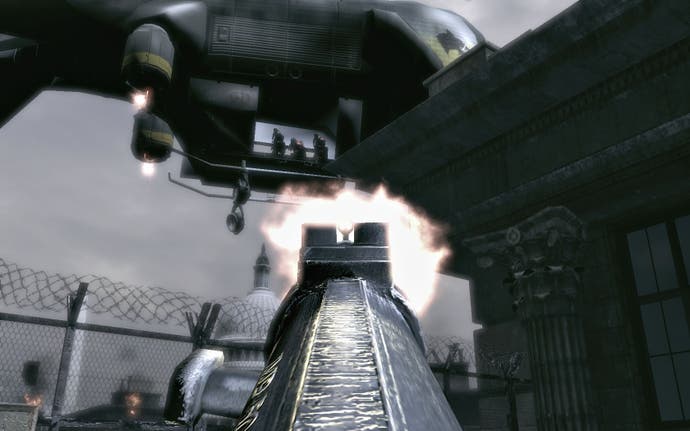Turning Point: Fall of Liberty
An alternative outcome to World War II: everyone loses.
Turning Point begins by asking what would have happened if Winston Churchill had died before World War II began. Then it immediately answers thus: Germany would have blitzed the UK into submission and, having fixed the trains and weaned us off dangling prepositions (a future to look forward to - sorry, to which we can look forward), invaded the USA by air in 1953. The game begins as you, some sort of construction worker erecting the steel framework of a high-rise building, get a close-up view of the initial bombardment of New York, as German ordnance dismantles your work and the city around you. Being a linear first-person shooter, this means your immediate goal is to navigate down to the ground using the only route available to you - alternative paths falling away, exploding or disintegrating in time-honoured fashion as you approach them.
Once you've gathered a weapon, you fight off a few paratroopers, using familiar Iron Sights (down the barrel) aiming for precision, and catch up with the local National Guardsmen, who send you to-ing and fro-ing, shooting Nazis, except next to a toppled Empire State Building, or in the White House or Tower of London. There's only ever one way to progress, with the general running-and-gunning punctuated by entrenched opposition. Sometimes you come up against more substantial armour, like a tank, and the prescribed answers are things like using that handily placed rocket launcher, or going down a manhole and planting some C4 on the tank's underside through a handily placed gap in the pavement, depending on which level you're on. For the most part though, you move forward, attack, clear the area, and then move on.

Developer Spark prefers to keep the action in close confines and that means corridors - whether it's in apartment buildings linked by rooftops and fire escapes, underground stations whose tracks are zigzagged with derailed train carriages, or relatively broad streets narrowed by debris and chain-link fencing. The health system doesn't rely on health-points but the more fashionable desaturation effect to represent discomfort, allowing you to recover quickly when you're out of the firing line, so your biggest threats are becoming overwhelmed away from natural cover, and the telltale clanking of the German Stielhandgranate, which is even more telltale thanks to a directional grenade damage indicator.
Since you're often operating in close quarters, Spark has implemented a system where you can grapple an enemy and bonk them on the head, take them as a human shield, or perform an environmental kill, the earliest of which sees you tossing a paratrooper off a building as he tries to cut free of his 'chute. Later you can smash heads through TVs or drown people in toilets. To break up the action and vary the terrain, you also climb ladders, and clamber hand over hand beneath pipes and along ledges. When you get to the end of a level, you're told how many people you've killed so far, which is pleasantly old-school, and then there's a brief intermission. One of the first informs you that the President and Vice President have both resigned, replaced by the Speaker of the House who surrenders on behalf of the US Armed Forces, only for a renegade General to ignore his orders and mount a resistance offensive.

Which is all the good bits and all the bits it's simple enough to explain without descending into angry rants, or thereabouts. Dealing with the rest will take longer, because Turning Point is almost relentlessly bland, frustrating, broken or inadequate. Probably the worst offender is the actual first-person shooting: aiming is as bad, if not worse than it was in Turok. No matter which sensitivity setting you choose, you're constantly trying to drag the aiming reticule into position, particularly using the Iron Sights feature, which ensures greater accuracy but barely lets you see what's in your sights. The aiming-assist is neither one thing nor the other, failing to alleviate all the painstaking back-and-forth over-compensation with the right stick. Generally you compromise by aiming roughly in the right direction and then trying to strafe yourself on target.
Actual combat is inevitably frustrating. Your enemies are dim-witted, but powerful in numbers, and flattered by your inability to actually point your gun at them, so you keep a distance where you can agonisingly picking them off. Even so, you mow down hundreds and hundreds, charting a contrived path up and down buildings, the route forever neatly aligned in unconvincing fashion, one doorway always safe from the wreathes of flame, one train door always open on either side of the carriage, one section of wall uncluttered by razor wire, one window always smashed as you approach along a rooftop ledge.








